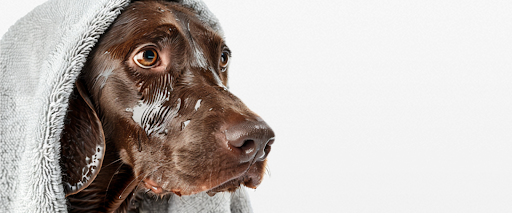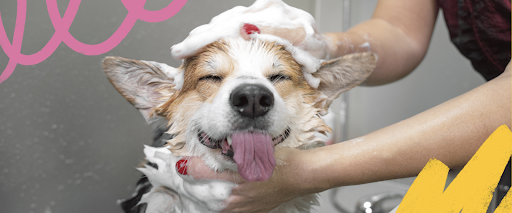Grooming is an essential part of keeping your dog healthy and happy, but for many dogs, it can be a source of significant anxiety. If your furry friend starts trembling or hiding at the mere mention of a grooming session, you’re not alone. Many pet parents face this challenge, but the good news is that there are effective ways to help calm a dog for grooming.
At Kontata, we specialize in providing a stress-free professional dog grooming experience for dogs of all temperaments, including those who are particularly anxious.
In this comprehensive guide, we’ll explore the reasons behind dog grooming anxiety and share expert grooming tips for anxious dogs to make the process as smooth and pleasant as possible for both you and your pet. Whether you’re considering professional dog grooming or prefer to groom at home, these strategies will help you turn a stressful experience into a calm one.
The Importance of Regular Grooming
Regular grooming is crucial for your dog’s health and well-being. It helps prevent matting, reduces shedding, keeps skin healthy, and allows for early detection of any skin issues or parasites.
For nervous dogs, maintaining a regular grooming routine can also help them become more comfortable with the process over time. While it may seem daunting at first, consistent, gentle grooming can build trust and reduce anxiety in the long run, making it easier to calm a dog for grooming.
Understanding Anxiety in Dogs During Grooming
Before we can address how to calm a dog for grooming, it’s essential to understand why they might be anxious in the first place. Dog grooming anxiety is a common issue, but it can be managed with the right approach. Dogs can develop anxiety for various reasons, including:
- Fear of Grooming Tools: The sound of clippers, the feel of brushes, or the sight of scissors can be intimidating for dogs unfamiliar with them.
- Unfamiliar Environments: Taking your dog to a grooming salon can be overwhelming, mainly if they’re not accustomed to being around other dogs or in new places.
- Past Negative Experiences: If your dog has had a bad experience during a previous grooming session, they might associate grooming with discomfort or fear.
- Sensitivity to Touch: Some dogs are simply more sensitive to being touched, especially in certain areas like their paws, ears, or tail.
Recognizing the signs of anxiety is crucial. Common indicators include:
- Trembling or shaking
- Panting excessively
- Whining or barking
- Trying to hide or escape
- Showing aggression (growling, snapping)
By understanding these signs, you can take proactive steps to alleviate your dog’s anxiety and help calm a dog for grooming.
Preparing Your Dog for Grooming
The key to helping a nervous dog feel more comfortable with grooming is to start early and proceed gradually. Here are some steps you can take to prepare your dog for grooming:
- Introduce Grooming Tools Early: If you have a puppy, begin by letting them explore grooming tools in a non-threatening way. Let them sniff and play with brushes, combs, and even turned-off clippers. This helps demystify these objects and reduces fear.
- Gentle Handling: Regularly touch and handle your dog’s paws, ears, and tail gently. This gets them used to being touched in areas that are typically groomed.
- Positive Reinforcement: Use treats and praise whenever your dog remains calm during handling or when they show interest in the grooming tools. Positive associations are influential in changing behavior.
- Practice Short Sessions: Start with very short grooming sessions, perhaps just brushing for a few minutes, and gradually increase the duration as your dog becomes more comfortable.
By taking these steps, you can help your dog build confidence and reduce their anxiety over time, making it easier to calm a dog for grooming.

Choosing the Right Groomer for Nervous Dogs
If you decide to take your dog to a professional groomer, it’s essential to choose one who is experienced in handling nervous dogs. Here’s what to look for when selecting a professional dog grooming service:
- Experience with Anxious Dogs: Ask if the groomer has experience with dogs who have anxiety or behavioral issues.
- Calm Environment: A good grooming salon should have a calm atmosphere, with separate areas for dogs to reduce stress from other pets.
- Positive Reinforcement Techniques: Ensure the groomer uses positive reinforcement and avoids punitive measures.
- Mobile Dog Grooming Options: Consider mobile dog grooming services where the groomer comes to your home. This can be less stressful for your dog since they don’t have to travel to an unfamiliar place.
At-Home Grooming Techniques for Anxious Dogs
If you prefer to groom your dog at home or want to supplement professional dog grooming, here are some grooming tips for anxious dogs to make the process easier:
- Create a Calm Space: Choose a quiet, familiar room for grooming. Minimize distractions and ensure the area is comfortable for your dog.
- Use Gentle Tools: Opt for soft-bristled brushes and quiet clippers to reduce noise and discomfort.
- Take Frequent Breaks: Break the grooming session into smaller parts. For example, brush for a few minutes, give a treat, then take a break, and repeat.
- Desensitize to Sounds: If your dog is scared of the clipper sound, start by letting them hear the clippers from a distance while giving treats, gradually moving closer over time.
These techniques can help make at-home grooming a positive experience for both you and your dog, helping to calm a dog for grooming.
Tools and Products to Calm Nervous Dogs
There are several products available that can help calm dog for grooming:
- Calming Collars and Diffusers: These release pheromones that have a calming effect on dogs.
- Anti-Anxiety Wraps: Similar to Thundershirts, these provide gentle pressure that can soothe anxious dogs.
- Natural Supplements: Ingredients like L-theanine or chamomile can have a calming effect. Always consult with your vet before starting any supplements.
- Calming Treats: Some treats are formulated with ingredients that promote relaxation.
While these products can be helpful, they should be used in conjunction with behavioral training for the best results when grooming nervous dogs.

Grooming Tips for Anxious Dogs: Quick Takeaways
Here are some quick grooming tips for anxious dogs to keep in mind when grooming nervous dogs:
- Exercise your dog before grooming to burn off excess energy.
- Speak in a calm, soothing voice throughout the process.
- Use high-value treats to keep your dog’s attention positive.
- Have someone assist you to keep your dog distracted with toys or treats.
- Always end on a positive note, with praise and rewards.
These quick tips will help you calm a dog for grooming and make the experience more enjoyable.
Conclusion
Grooming doesn’t have to be a stressful experience for your dog. By understanding the reasons behind their dog’s grooming anxiety and using the right grooming tips for anxious dogs, you can help your pet feel more comfortable and even enjoy their grooming sessions.
If you’re ready to give your dog the best professional grooming experience, contact Kontata today to schedule an appointment or learn more about our services.
FAQs
How can I tell if my dog is anxious during grooming?
Look for signs like trembling, panting, whining, trying to escape, or showing aggression.
What should I do if my dog is aggressive during grooming?
If your dog shows aggression, it’s best to stop immediately and consult a professional dog trainer or behaviorist. Aggression can indicate severe anxiety or pain, and it needs to be addressed carefully.
Are there any medications that can help calm my dog during grooming?
Yes, there are anti-anxiety medications that your vet can prescribe. However, these should be used as a last resort and only under veterinary supervision.
Can I groom my nervous dog at home?
Yes, with patience and the right grooming tips for anxious dogs, many dogs can be groomed at home. Start slowly and make the experience positive.
How often should I groom my nervous dog?
The frequency depends on your dog’s breed and coat type, but regular, short sessions are better than infrequent, long ones for grooming nervous dogs.



